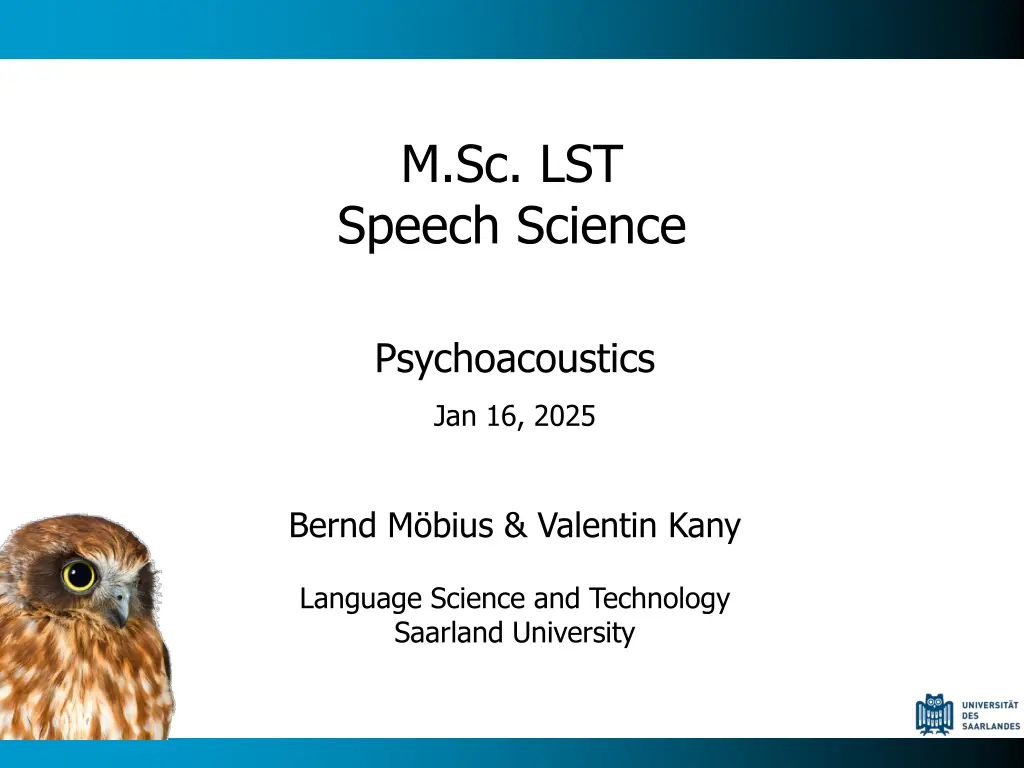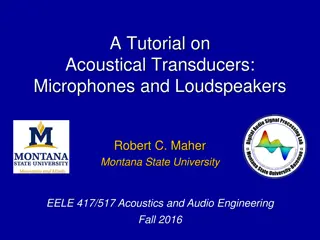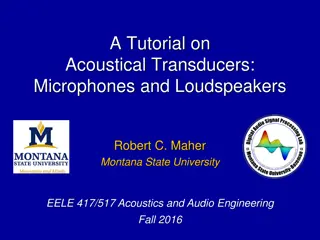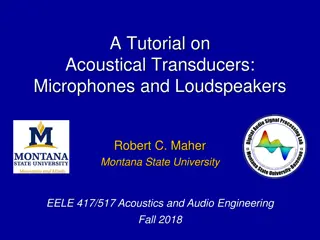
Psychoacoustics and Auditory Perception Overview
Explore the fascinating world of psychoacoustics and auditory perception, including topics such as the anatomy and physiology of the auditory system, loudness perception, pitch perception, equal-loudness contours, auditory frequency scales, and more. Learn about the perceptual correlates of acoustic sound intensity and frequency, as well as the thresholds and differences in loudness and pitch perception. Delve into the complexities of how the auditory system processes and interprets sound, providing valuable insights into speech and language science.
Download Presentation

Please find below an Image/Link to download the presentation.
The content on the website is provided AS IS for your information and personal use only. It may not be sold, licensed, or shared on other websites without obtaining consent from the author. If you encounter any issues during the download, it is possible that the publisher has removed the file from their server.
You are allowed to download the files provided on this website for personal or commercial use, subject to the condition that they are used lawfully. All files are the property of their respective owners.
The content on the website is provided AS IS for your information and personal use only. It may not be sold, licensed, or shared on other websites without obtaining consent from the author.
E N D
Presentation Transcript
M.Sc. LST Speech Science Psychoacoustics Jan 16, 2025 Bernd M bius & Valentin Kany Language Science and Technology Saarland University
Overview Anatomy and physiology of the auditory system Speech perception auditory perception psychoacoustics auditory-perceptual phonetics
Perception of loudness Loudness: perceptual correlate of acoustic sound intensity differences in loudness are perceived on a logarithmic scale (e.g., decibel/[dB]) by the auditory system 0 dB is equivalent to sound pressure level of a reference signal (at perceptual threshold at 1 kHz) doubling of loudness is equivalent to increase by 10 dB perceptual threshold ("just noticeable difference", JND) for pure tones: approx. 1 dB
Equal-loudness contour [Johnson, 1997, p.54]
Perception of pitch Pitch: perceptual correlate of acoustic frequency auditory frequency range: approx. 20 20,000 Hz frequency selectivity: resolution of frequency components of a complex (e.g., speech) signal: optimal below 500 Hz logarithmically decreasing above 500 Hz JND for pure tones: below 1000 Hz: approx. 0.5% at higher frequencies: approx. 5% auditory frequency scale (e.g., Bark [Z]): auditory system is more sensitive to frequency differences in low frequencies than in high frequencies
Auditory frequency scale [Johnson, 1997, p.55]
Auditory plane and auditory thresholds threshold of feeling conversation equal-loudness contours threshold of audibility [Goldstein, 1997, p.354]
Loudness differences Sound pressure [ Pa] Sound source audibility threshold soft whisper quiet office normal conversation city bus subway train heavy thunder pain SPL [dB] 20 0 200 20 40 60 80 2 000 20 000 200 000 2 000 000 20 000 000 200 000 000 100 120 140 Sound pressure (Schalldruck), measured in micro-Pascal objective measurement of sound pressure differences Sound pressure level (Schalldruckpegel), measured in dB subjective sensation of loudness differences
Perception of duration Duration: perceptual correlate of physical property "time" temporal processing and resolution: over which temporal interval can the auditory system integrate information? detection of gaps in otherwise continuous signals JND: duration differences: >20 ms at 500 - 1500 Hz detection of gaps of 6 8 ms fast spectral changes within <30 ms are not analyzed, but perceptually integrated
Speech perception Psychoacoustic properties of auditory system are compliant with requirements of speech perception; e.g.: very good frequency resolution in low-frequency range fundamental frequency analysis (voicing, intonation) medium frequency resolution in mid-frequency range formant analysis and tracking (vowels, sonorants) poor frequency resolution in high-frequency range rough spectral patterns (fricatives) temporal integration supports capturing coarticulation, and good temporal resolution supports recognition of stop releases (but stop bursts are too short for spectral analysis) Co-evolution, or adaptation of production system to auditory system?
Speech intelligibility Intelligibility of speech depends on many factors, including: frequency band (e.g., telephone 350 3500 Hz) loudness duration of segments of speech and gaps semantic content (top-down processing) and semantic predictability robustness of speech signals gaps <200 ms hardly disturb intelligibility gaps >500 ms destroy intelligibility disturbing noise (signal-to-noise ratio, SNR)



